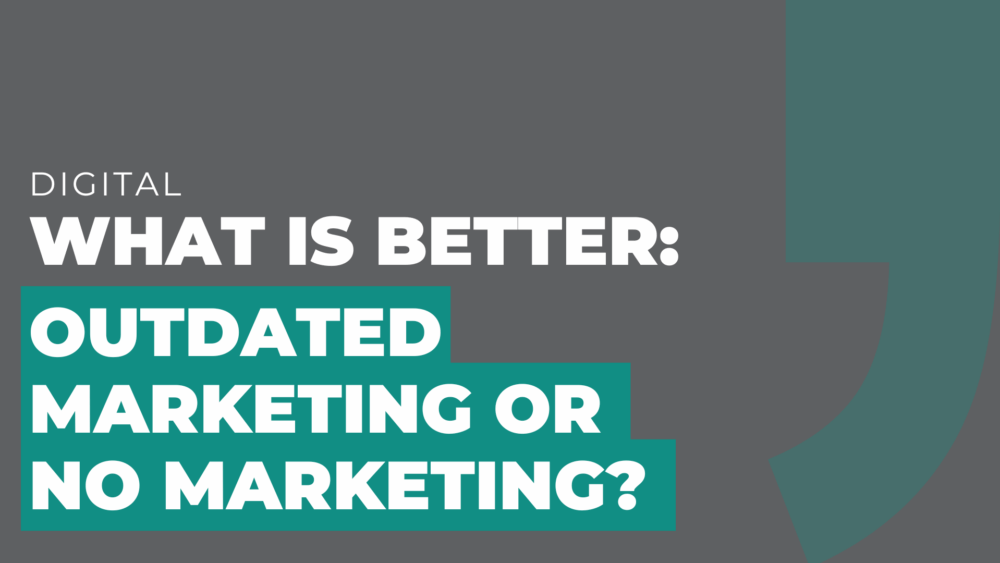With the rapid pace of change in technology and consumer behavior, outdated marketing can do more harm than good to a brand’s image and overall company performance.
While outdated marketing is bad, having no marketing at all can also be detrimental to a company’s success.
In this article, we will explore the pros and cons of both outdated marketing and no marketing in order to determine which is truly better for businesses.
The Dangers of Outdated Marketing
Outdated marketing can be a major detriment to your brand‘s image for several reasons:
- Loss of Relevance: Brands that fail to keep up with the latest marketing trends risk losing their relevance in the eyes of consumers. This can lead to a decline in brand awareness and ultimately, a drop in sales.
- Negative Perception: By using outdated marketing tactics, a brand may inadvertently signal to its target audience that it is out of touch or unwilling to adapt to modern ways of doing business. This can result in feelings of distrust among potential customers.
- Wasted Resources: Investing time, money, and effort into outdated marketing strategies can lead to poor return on investment (ROI), as these methods are often less effective at reaching and engaging today’s consumers.
- Competitive Disadvantage: Brands that rely on outdated marketing tactics will struggle to compete with those that are leveraging current, innovative strategies to connect with their audiences.
The Consequences of No Marketing
While outdated marketing can damage a brand’s image, having no marketing at all can also have severe consequences:
Lack of Brand Awareness: Without any marketing efforts, potential customers may not even be aware that a brand exists, making it impossible for them to consider purchasing its products or services.
Missed Opportunities: In the absence of marketing, businesses miss out on opportunities to connect with their target audience, build relationships, and drive sales.
Stagnant Growth: Without marketing, a brand’s growth potential is significantly limited, as it will struggle to attract new customers and expand its market share.
Is Traditional Marketing Still Effective?
While digital marketing has taken center stage in recent years, this doesn’t mean that traditional marketing methods are entirely ineffective.
For certain industries and target audiences, traditional marketing can still prove to be a valuable tool for reaching and engaging customers.
However, brands must carefully consider their target audience and objectives to determine which marketing channels will be most effective for their specific needs.
What Causes Bad Marketing?
Bad marketing can stem from several factors:
Lack of Research: Insufficient understanding of the target audience, competitors, and industry trends can result in marketing campaigns that fail to resonate with consumers.
Poor Execution: Even with a solid marketing strategy in place, poor execution can lead to disappointing results. This may include unclear messaging, low-quality visuals, or a lack of follow-through on campaign promises.
Inflexibility: Brands that are unwilling or unable to adapt to changing market conditions or consumer preferences risk falling behind and becoming irrelevant.
Insufficient Budget: A lack of adequate funding can hinder a brand’s ability to execute high-quality marketing campaigns, resulting in subpar efforts that fail to make an impact.
Outdated Marketing Hurts a Brand
It is generally better to have no marketing than outdated marketing.
Outdated marketing can damage a brand’s image, create negative perceptions, waste resources, and put the brand at a competitive disadvantage.
While having no marketing can result in a lack of brand awareness and missed opportunities, it does not actively harm the brand’s reputation like outdated marketing can.
However, the ideal scenario is to invest in current, effective marketing strategies that resonate with the target audience and drive growth.
Brands should continuously evaluate their marketing efforts, stay informed about industry trends, and adapt their strategies to maintain relevance and effectively engage their target audiences.
One real-life example of how outdated marketing hurt a brand is the case of Kodak.
Kodak, once a dominant player in the photography industry, failed to adapt its marketing and product strategies to the changing landscape brought about by the rise of digital photography.
Kodak’s marketing efforts continued to focus heavily on promoting traditional film-based cameras and printing services, even as consumer preferences shifted towards digital cameras and online photo sharing.
This outdated marketing approach, coupled with their slow response to the digital revolution, led to a negative perception of the brand as being out of touch with modern technology and consumer needs.
As a result, Kodak lost significant market share to competitors who embraced digital technology and adapted their marketing strategies accordingly.
The brand’s inability to stay relevant eventually led to its bankruptcy in 2012.
While Kodak has since restructured and reentered the market, its brand image still suffers from the consequences of its outdated marketing and slow response to industry changes.
The key to becoming timeless as a brand really lies in continuously evolving and staying relevant in the eyes of consumers.
At the End of the Day
Outdated marketing can severely damage a brand’s image and overall company performance, often more so than having no marketing at all.
Brands must remain agile and adaptable, staying up-to-date with the latest marketing trends to maintain relevance and effectively engage their target audiences.
While traditional marketing methods may still hold value in certain situations, businesses must carefully evaluate their unique needs and objectives to determine the most effective marketing strategies for their brand.


Comments are closed.